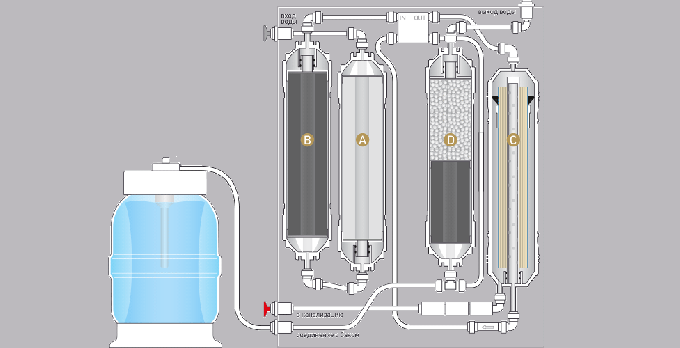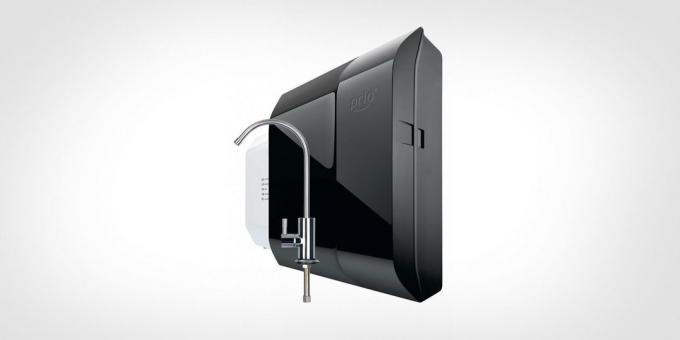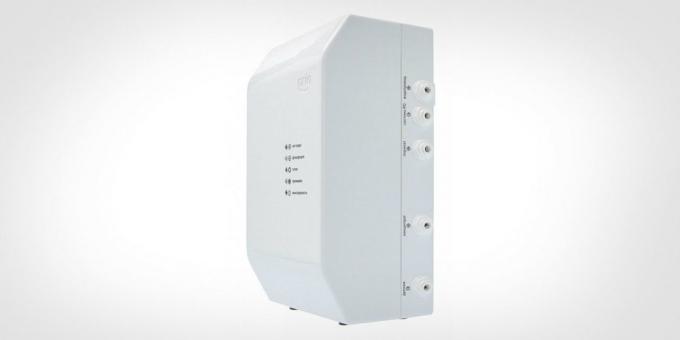How to choose a good water filter and save
Tips / / December 19, 2019
How to clean water, modern filters
sorption purification
There are several ways of water treatment used in modern filters. Cheapest and common filters - sorption. Their operation is based on the principle of adsorption - absorption of substances from the body of solid solution or fluid bed reactor. The adsorbent in such filters is most commonly used activated carbon.
Sorption filters are cheap, good clean water from the chlorine, the major pollutants such as sand and rust, and do not require installation. However, they clean the water is not very high quality, does not protect against bacteria, viruses and hardness salts. Water should be boiled anyway, and when boiled will form a scum on the teapot.
membrane cleaning
This is a more modern and high-quality way of cleaning. A key element here - semipermeable membrane with the smallest pores, which retains the dusts. The water passes through the membrane under pressure, purified enters the storage tank and the dirty water with impurities goes down the drain.
There are several types of membrane cleaning:
- Microfiltration. Used membrane with holes ranging in size from 0.015 to 5 microns, rolled into rolls or tube. Water is supplied under a pressure of 2-3 bar.
- Ultrafiltration. Used membrane with smaller pore size in 0.015-0.02 microns. It operates at high pressure - up to 6 bar.
- Reverse osmosis. Used membrane with the fine pores of 1 Å (0.0001 micrometers). They allow only water molecules and nothing else. At the same time, modern systems do not require a high pressure, enough 1.5-2 atmospheres.
Reverse osmosis system is now one of the most popular and high-quality membrane treatment systems.
reverse osmosis water purification system
Apart from the semipermeable membrane in the current reverse osmosis water purification systems have prefilters and postfilters. For clarity, we consider how the filter in the reverse osmosis system with mineralization Expert Osmos MO520 from the company Prio.

First, tap water enters the mechanical prefilters (A and B), which is removed from it particles of a size greater than 0.5 micron, rust, sand and other major impurities. Thereafter, water under pressure enters the membrane (C). Passing through it, the liquid is cleaned from the rest: inorganic and organic compounds, heavy metals, bacteria and viruses. Reading the water goes into a storage tank, and unrefined - down the drain.
Before we proceed to the user, the water from the tank passes through an additional post-filter-mineralizer (D), which is purified from foreign odors and saturated minerals.
However, not all reverse osmosis systems clean equally well. Primarily the quality of water treatment depends on the main element of the system - the membrane.
How to determine the quality of the membrane
Reverse osmosis membranes are different in the degree of purification and selectivity, resistance to chlorine and bacterial contamination, filtration rate, necessary for the pressure and degree of pH-correction water.
One of the best options on the market today - the Japanese Toray membrane from a polymer composite film. It has high scores on all the above parameters.
Toray membranes are quite expensive, but they provide the highest quality of cleaning. In this case, you can not rely on the assurances of producers, and to check the quality of the membrane works independently with the help of TDS-meters, or salimeters.
TDS-meter - a device which measures the concentration of impurities in the liquid and indicates how many solid particles per million (ppm) is in the test water.
For example, water suitable for drinking, has a rate from 50 to 170 ppm, and ideally reading water - from 0 to 50 ppm.
In terms of tap water at 260 ppm Toray membrane provide the output product with 8 ppm, of water and if especially dirty water system - about 480 ppm, - the output will provide the membrane with water indicators 13 ppm.
Cheaper membranes, such as Chinese, allow to obtain the water is not cleaner than 60-80 ppm - potable, but still pretty tough.
Apart from the quality of water treatment, Toray membranes have several advantages over the cheaper options. They operate at an inlet pressure of from 2 atmospheres, and their performance allows you to create a reverse osmosis system without storage tank - modern direct-flow system.
Direct flow reverse osmosis system
What it is
This latest water treatment systems that require less water and filtered much more quickly. Here is an example of such a system - Econic Osmos Stream OD320.

In contrast to the system with a tank, after purification prefilter (K870) and the membrane (K857) not water is fed into the storage tank, and through the post-filter-mineralizer directly to the user.
Let's see what this system is beneficial for example Osmos Stream Series filters from the company «Prio New Water".
system Benefits
density
To get rid of bulky tank can be considered a true revolution in the reverse osmosis filtration. Now the kitchen size and space under the sink does not matter: the filter takes up very little space.
Here, for example, direct-flow looks set split system Expert Osmos Stream MOD600 - all neat, compact and beautiful.

No restrictions on the amount of water
When the tank reverse osmosis water system ends, you have no choice but to wait until it is filled again. With straight-through systems, such problems do not arise. Osmos Stream system filtered water at a time when you turn on the tap, they do not accumulate and do not advance. In this case, the water flow is not restricted. No need to rely on the tank filling, you can always turn on the tap and get up to 1500 liters per day.
Long life consumables
Some Line Filter Prio include automatic membrane cleaning system, which significantly extends the life of expensive consumable.
purification system Prio Osmos Stream series MOD, OUD or OD360 Prio® Jet equipped with an automatic control unit which flushes the membrane after each cycle incorporating a pump unit. Due to this, the membrane is longer.

saving water
One of the major disadvantages of conventional reverse osmosis filter with a tank - water usage. Purified water is only about 20% of the total weight of the incoming water, the rest is discharged into the sewers.
In-Line Filter managed to solve this problem. The high selectivity of the membrane and a filtration quality can significantly reduce the consumption of water discharged into the sewer. Typically with such a filter in the drainage system is sent no more than ⅓ total volume, and purified water is ⅔. In the year out savings of several tons!
In addition, the direct-flow system more easy to maintain and require less binding cartridges, which also helps to save considerable amounts of money. For example, in a once-through system Prio Econic Osmos Stream OD310 necessary to change all three elements: a pre-filter made of a pressed activated carbon postfilter of granular activated carbon and a membrane Toray. Unlike conventional filter cartridges 5-6, a minimalist saves money.
Change cartridges is recommended every six months to a year, and the membrane, and even rarer - only once every three years.
Compared with conventional filters, reverse osmosis through-flow models allow you to save significant amounts of money. But whether they are cost-effective compared with no filters at all? Let's count, it would be more profitable: to buy water or use a high-quality straight-through filter.
How Line Filter help save
We will not compare the direct flow reverse osmosis filters to conventional sorption, since the latter does not provide a quality cleaning. Even filters with ion exchange resin does not clear the water from hardness salts and bacteria, whereby it will still be boiled continuously removing scale from the kettle.
Clean and tasty water from the reverse osmosis filters can be compared only with the purchase, and we will compare the costs of purchase and maintenance of the filter with the cost of purified water bottles.
Five-liter bottles of purified water cost about 80 rubles. On average, a family uses about 4 liters of water a day: tea and coffee, cooking, simply drinking water. It turns out that in the year 1460 the family need liters of drinking water - about 290 bottles, which will cost 23,200 rubles.
Now calculate how much money will be needed for the purchase and maintenance of the filter. For example, take Prio Econic Osmos Stream OD310 for 11 950 rubles. Add the cost of replacement of two cartridges: 870 + 790 = 1 660 rubles.
Total turns 13 610 rubles per year - almost twice cheaper than the purchase water.
Even premium model Prio - split system with mineralization Expert Osmos Stream MOD600 for 25,880 rubles - will be repaid in full within a year and a half, after which you'll save about 25 000 rubles year.
In this case, reverse osmosis filter membrane of Toray, pass only water molecules can provide even better quality than plants, purifying water for sale. After all, part of the purchase drinking water taken from the public water system, so that it may well remain chlorination by-products.
You can check the quality of the purchase of water by means of TDS-meter and decide whether to pay money for it. But even if it will be perfect, once-through filters "Prio New Water"Will help to achieve the same much cheaper and faster without having to carry the heavy bottles.
Learn more about Prio systems

